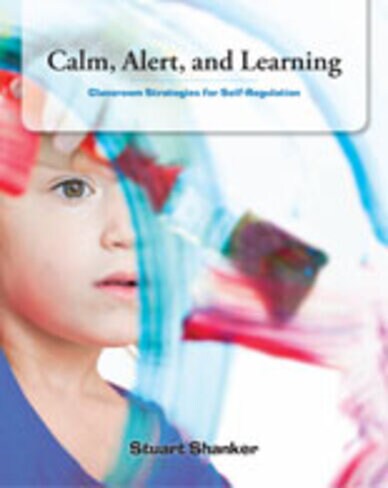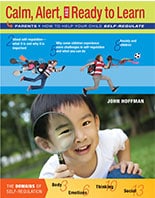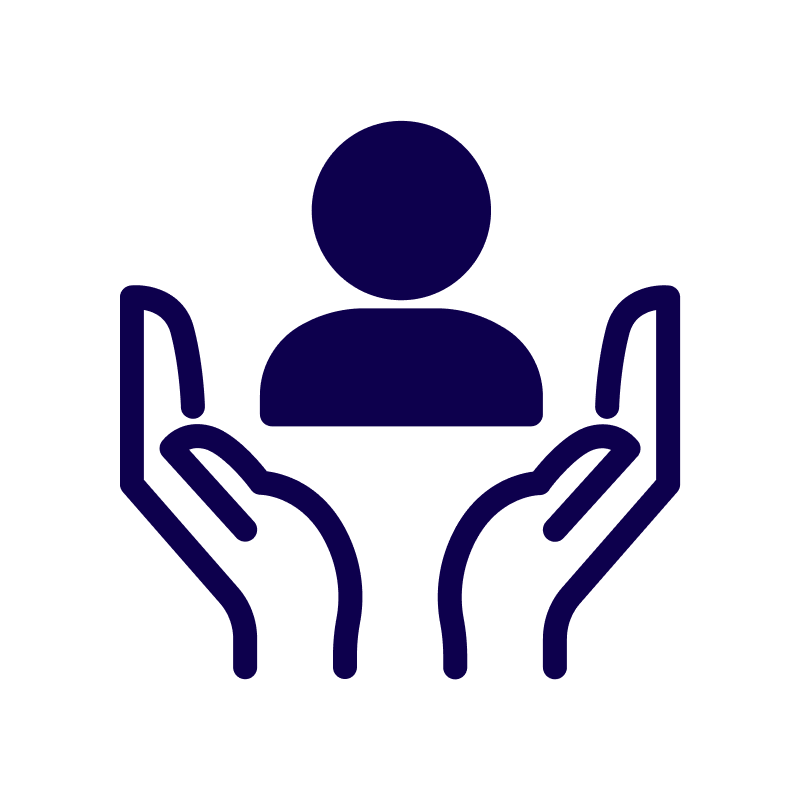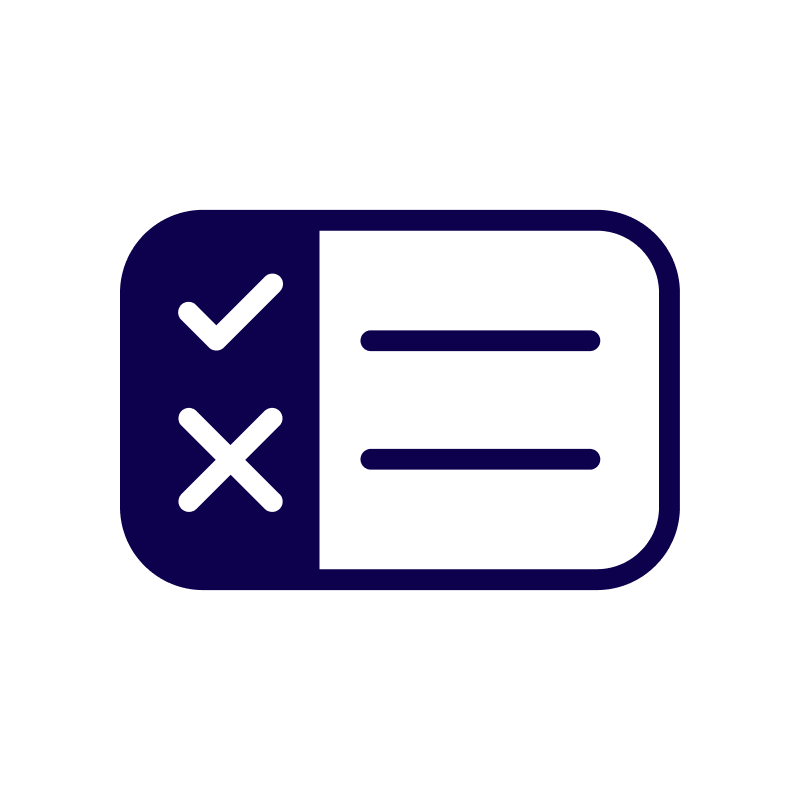
Imprint
Pearson Canada
Author(s)
Stuart Shanker, John Hoffman
Recent research tells us that one of the keys to student success is self-regulation – the ability to monitor and modify emotions, to focus or shift attention, to control impulses, to tolerate frustration or delay gratification.
But can a child’s ability to self-regulate be improved?
Canada’s leading expert on self-regulation, Dr. Stuart Shanker, knows it can and that, as educators, we have an important role to play in helping students’ develop this crucial ability.
Distinguished Research Professor at York University and Past President of the Council for Early Child Development, Dr. Shanker leads us through an exploration of the five major domains—what they are, how they work, what they look like in the classroom, and what we can do to help students strengthen in that domain.
Features and Benefits
- Provides an overview of the most current research on self-regulation in an accessible, practical format
- Includes case studies of teachers, students, classrooms, and entire schools where self-regulation techniques have enhanced students’ potential
- Details tips and suggestions that can be implemented quickly, easily, and affordably
- Supplies online content linking to resources and content for professional learning and parent communication
How to help your child self-regulate
Children, especially young children, are just beginning to understand and manage their behaviours and emotions. As teachers, you are already developing these self-regulation skills in your classroom. Parents can also help their child learn these valuable abilities and skills. That’s why we developed Calm, Alert, and Ready to Learn, a booklet that provides information, tips, and strategies on self-regulation. It is based on a best-selling book Calm, Alert, and Learning: Classroom Strategies for Self-Regulation, written by Dr. Stuart Shanker.

Features and Benefits
- Inexpensive 16-page booklet that explains self-regulation in parent-friendly language
- Helps parents collaborate with teachers in the development of self-regulation skills by providing practical tips and strategies for use outside the classroom
- Ideal for presentation at a curriculum night or to send home with students
- PowerPoint presentation and modifiable Cover Letter available for download
US and International Customers:
Please email schoolinternational_canada@pearsoned.com for information on how to order.
Authors

Dr. Stuart Shanker
Stuart Shanker is a Distinguished Research Professor of Philosophy and Psychology at York University. Dr. Shanker is currently serving as Director of the Milton and Ethel Harris Research Initiative (MEHRI) at York University, a privately funded initiative whose goal is to build on new knowledge of the brain’s development, and help set children (including those with developmental disorders) on the path towards emotional and intellectual health.Dr. Shanker has just been appointed the Director of EPIC: an international initiative created to promote the educational potential in children by enhancing their self-regulation.
He has served as the Director of the Council of Human Development for the past ten years; Director of the Canada-Cuba Research Alliance for the past six years; and he was the first President of the Council of Early Child Development in Canada. Over the past decade he has served as an advisor on early child development to government organizations across Canada and the US and countries around the world, among them Australia, Colombia, England, Ireland, Macedonia, Madagascar, Mexico, Northern Ireland, Peru, Romania and Serbia. Most notable among these is his involvement in the creation of the new early learning program in Ontario (viz. "The Pascal Report," for which he also wrote the preface).
John Hoffman
John Hoffman is one of Canada’s leading writers in the area of parenting, child development, and children’s mental health. He has written 15 educational booklets for parents, over 200 articles on parenting in the popular media, and has worked closely with Dr. Stuart Shanker to help make the concept of self-regulation accessible to parents.
Resource Overview
We are in the midst of a revolution in educational thinking and practice. Scientific advances in a number of fields point to a similar argument—that how well students do in school can be determined by how well they are able to self-regulate. Some theorists believe that self-regulation should now be considered a more important indicator of educational performance than IQ (Blair & Diamond, 2008; Duckworth & Seligman, 2005; Shonkoff & Phillips, 2000).
So what is self-regulation and what does it look like in your classroom?
Educational research in the area of self-regulation has been largely concerned with such matters as a student’s ability to set goals and monitor progress; seek clarification or assistance when needed; assess and reflect critically on personal learning strengths and weaknesses; and employ learning strategies and aids to assist in problem solving (Zimmerman, 1994). These traits are especially relevant to the adolescent learner. Indeed, the neural systems related to these functions are amongst the last to mature in the growth of the human brain. But over the past decade our understanding of the development of self-regulation in the early years, which lays the foundation for these higher metacognitive functions, has moved forward in a number of domains.
One of the best sources of research on these foundational aspects of self-regulation is Roy Baumeister and Kathleen Vohs’s Handbook of Self-Regulation: Research, Theory, and Applications (2011). In the handbook, the various authors involved describe self-regulation as the ability to
- attain, maintain, and change one’s level of energy to match the demands of a task or situation
- monitor, evaluate, and modify one’s emotions
- sustain and shift one’s attention when necessary and ignore distractions
- understand both the meaning of a variety of social interactions and how to engage in them in a sustained way
- connect with and care about what others are thinking and feeling—to empathize and act accordingly
When we think of students who are successful in our classrooms, we see evidence of these abilities. When we think of students who are less successful, we can just as easily see evidence that one or more of these abilities needs strengthening. Perhaps a student cannot break her attention on a task to start to listen to her teacher. Another student may be desperate to have friends but constantly misses the social cues his peers provide. Both students exhibit difficulties in domains of self-regulation.
Self-regulation is increasingly being seen as essential for enabling children to respond efficiently and effectively to the everyday challenges they face in and out of school. The better we understand self-regulation, the better we can implement educational strategies that enhance students’ capacity to learn and develop the skills necessary to deal with life’s challenges. Many of us are at the beginning of this journey and no doubt will learn much more about self-regulation and how we can enhance it in every child in every classroom. For now, I hope this resource will provide a foundation for understanding what self-regulation is, what it looks like, and how to foster it in your classroom.
The Five-Domain Model of Self-Regulation
In this resource, we look at self-regulation through an exploration of five domains:
- The Biological Domain
- The Emotional Domain
- The Cognitive Domain
- The Social Domain
- The Prosocial Domain
In each of us, there are complex links between and among these five domains. We will explore those links more deeply in the chapters that follow. To get started, we will outline each domain. Keep in mind that, throughout this introduction and the following chapters, our primary goal is to help students to achieve optimal self-regulation, a state of calm focus and alertness appropriate for learning in a classroom.
There are six critical elements to optimal self-regulation. These elements span the five domains and represent, in a concise way, what we hope we can help you to move toward with your students.
Six Critical Elements to Optimal Self-Regulation
- when feeling calmly focused and alert, the ability to know that one is calm and alert
- when one is stressed, the ability to recognize what is causing that stress
- the ability to recognize stressors both within and outside the classroom
- the desire to deal with those stressors
- the ability to develop strategies for dealing with those stressors
- the ability to recover efficiently and effectively from dealing with stressors
Companion Content
Calm, Alert, and Learning
Professional Resources
Developmental Individual Difference Relationship-based (DIR®) Model
Developmental Individual Difference Relationship-based (DIR®) Model
AutismWeb™ —a Parent's Guide to Autism Spectrum Disorders. Autism Teaching Methods: DIR®/Floortime. © AutismWeb 2000–2012
http://www.autismweb.com/ click on • DIR®/Floortime
click on • DIR®/Floortime
Canadian Self-Regulation Initiative
Copyright © 2012 School District 36. All Rights Reserved.
http://www.self-regulation.ca/
Parent Resources
What Is Self-Regulation?
 .PDF 23kb 2pgs
.PDF 23kb 2pgs
Chapter 1: The Biological Domain
Chapter 1 - Professional Resources
Interactive Regulation
PSYCHOANALYTIC PSYCHOLOGY (1998) 15(4), 480–516.
Co-constructing inner and relational processes: Self- and mutual regulation in infant research and adult treatment. Beatrice Beebe and Frank M. Lachmann. © 2012 American Psychological Association.
http://psycnet.apa.org/psycinfo/1998-12685-002
The Reggio Emilia Approach
Reggio Kids Childcare Centres—A look at The Reggio Approach. © 2006 Wenex Technologies
http://www.reggiokids.com/ click on About Reggio Kids →The Reggio Approach
click on About Reggio Kids →The Reggio Approach
Alert Program®
The ALERT Program. Copyright 2012 Therapy Works Inc.
http://www.alertprogram.com/
Chapter 1 - Parent Resources
How Biological States Affect Children’s Behaviour
 .PDF 23kb 2pgs
.PDF 23kb 2pgs
Bedtime Routines
 .PDF 20kb 1pg
.PDF 20kb 1pg
The Importance of Parental Self-Regulation
 .PDF 23kb 3pgs
.PDF 23kb 3pgs
How Parenting Supports Biological Self-Regulation
 .PDF 25kb 3pgs
.PDF 25kb 3pgs
Helping Children to Manage Transitions
 .PDF 20kb 1pg
.PDF 20kb 1pg
The Importance of Physical Activity in Biological Self-Regulation
 .PDF 23kb 2pgs
.PDF 23kb 2pgs
Several Ways to Help Children Regulate
 .PDF 20kb 1pg
.PDF 20kb 1pg
Chapter 2: The Emotional Domain
Chapter 2 - Professional Resources
Malcolm Gladwell
http://www.gladwell.com/index.html
Emotions and Learning
Center for Development and Learning. THE CONNECTIONS BETWEEN EMOTIONS AND LEARNING
By Candy Lawson, Ph.D.
http://www.cdl.org/index.html click on Library → “L” under Authors A-Z → Candy Lawson
The Greenspan Floortime Approach
Learn Floortime from Dr. Stanley Greenspan. Copyright 2012 by the Greenspan Floortime Approach
http://stanleygreenspan.com/
Daniel Goleman
Emotional Intelligence. © 2012 – Daniel Goleman
http://danielgoleman.info/ click on Topics → Emotional Intelligence
Collaborative for Academic, Social, and Emotional Learning (CASEL)
©2000–2011 CASEL. All rights reserved.
http://casel.org/
Interpersonal Relationships
http://www.wikipedia.org/ search “interpersonal relationship”
The Impact of Students’ Social and Emotional Learning
©2000–2011 CASEL. All rights reserved.
CHILD DEVELOPMENT, January/February 2011, Volume 82, Number 1, Pages 405–432. The Impact of Enhancing Students’ Social and Emotional Learning: A Meta-Analysis of School-Based Universal Interventions. Joseph A. Durlak, Roger P. Weissberg, Allison B. Dymnicki, Rebecca D. Taylor, and Kriston B. Schellinger.
http://casel.org/ search “The Impact of Enhancing Students’ Social and Emotional Learning”
Adolescent Brain Development
Copyright © 2012 ACT for Youth Upstate Center of Excellence. All rights reserved.
Adolescent Brain Development
http://www.actforyouth.net/ click on Publications and Presentations → search “adolescent brain development”
Animal Planet
Copyright © 2012 Discovery Communications, LLC.
http://animal.discovery.com/
Dr. Paul Ekman
Copyright 2011 Paul Ekman Group LLC.
http://www.paulekman.com/
Reading Faces
Your amazing brain…
http://www.youramazingbrain.org/ click on Test yourself → Reading faces
Yoga for Kids
Copyright © 2012 Cruz Bay Publishing, Inc. an Active Interest Media company
http://www.yogajournal.com click on LIFESTYLE → Family & Parenting → Popular Family & Parenting Articles/Yoga for Kids
SNAP® (Stop Now and Plan)
© 2008 – Canadian Safe School Network
http://www.canadiansafeschools.com/home.htm click on Resources & Research → CSSN Programs: → SNAP®
© Copyright 2001 Child Development Institute (CDI). SNAP ® is a registered trademark of CDI.
http://www.stopnowandplan.com/
Dealing Effectively with Student Emotions
The Optimistic Child by Martin Seligman
© 1996-2012, Amazon.com, Inc. or its affiliates
http://www.amazon.ca/ search “The Optimistic Child”
TAYLOR & FRANCIS Early Education & Development, 23 (2), March 2012, 202–226. Preservice teachers’ emotion-related regulation and cognition: Associations with teachers’ responses to children’s emotions in early childhood classrooms. Rebecca Anne Swartz and Nancy L. McElwain
http://www.tandfonline.com/ search “Preservice teachers’ emotion”
Chapter 2 - Parent Resources
Dealing with Our Own Emotions (Parenting When We Are Upset)
 .PDF 20kb 1pg
.PDF 20kb 1pg
The Link Between Emotions, Behaviour, and Learning
 .PDF 23kb 2pgs
.PDF 23kb 2pgs
Responding To Negative Emotions
 .PDF 20kb 1pg
.PDF 20kb 1pg
Harsh Discipline Does Not Enchance Emotional Self-Regulation
 .PDF 20kb 2pgs
.PDF 20kb 2pgs
Developing an Emotional Language
 .PDF 20kb 1pg
.PDF 20kb 1pg
Strategies for Helping Children Deal with Negative Emotions
 .PDF 22kb 2pgs
.PDF 22kb 2pgs
Supporting Emotional Development with Positive Emotions
 .PDF 21kb 2pgs
.PDF 21kb 2pgs
Chapter 3: The Cognitive Domain
Chapter 3 - Professional Resources
Perceptual Pleasure and the Brain
AMERICAN SCIENTIST, May–June 2006
Perceptual pleasure and the brain. Irving Biederman and Edward Vessel
http://www.americanscientist.org/ Search “DOI:10.1511/2006.3.247”
Classroom Management Tools: Attention Getters
© 2012 A to Z Teacher Stuff Tips for Teachers. All Rights Reserved.
http://tips.atozteacherstuff.com/ click on tips → • Attention Getters
Early Learning Initiatives
Copyright © 2011, Province of British Columbia. All rights reserved.
http://www2.gov.bc.ca/ search “Early Learning Framework”
New Brunswick Department of Education and Early Childhood Development, 2008.
http://www.gnb.ca/ click on Welcome → search “Early Learning and Child Care Curriculum”
Early Childhood Learning Division, Department of Education. September, 2011. Newfoundland and Labrador.
Developing a Provincial Early Childhood Learning Strategy: What We Heard
http://www.gov.nl.ca/ click on Departments/Agencies → Education → search “What We Heard”
Games to Enhance Auditory Discrimination
© 2012 Posit Science. All Rights Reserved.
http://www.positscience.com/ click on Games & Teasers → Brain games for kids → Sound Discrimination → Bear Wear
http://www.positscience.com/ click on Games & Teasers → Brain games for kids → Sound Discrimination → Tone-A-Matic
Multimodal Adaptive Technologies
AssistiveWare®
http://www.assistiveware.com/ click on Products → Communication Products / Prologquo2Go
1997–2012 Scientific Learning Corporation. All rights Reserved.
http://www.scilearn.com/
Attention Deficit Hyperactivity Disorder
U.S. National Library of Medicine
http://www.nlm.nih.gov/ search “childhood hyperkinesis”
Head-Toes-Knees-Shoulders Game
© Copyright 2012 The Globe and Mail Inc. All Rights Reserved.
http://www.theglobeandmail.com/ search “video head toes knees test”
Online Games for Children with Poor Visual-Spatial Processing
The JigsawPuzzles.com
http://thejigsawpuzzles.com/
Copyright © 2004-2012 A Playground for the Mind
http://playwithyourmind.com/ click on Brain Exercises → Visual-Spatial
Interactive Dance Games
Just Dance
http://just-dance-thegame.ubi.com/
DanceDanceRevolution
http://www.ddrgame.com/
FABtale
© 2011 FABtale Productions Pty Ltd.
http://fabtale.com/
Online Memory Games
Copyright © Free Games.WS
http://www.freegames.ws/ click on games (centre, last point) → Simon
Copyright ©2012 SPIL GAMES B.V. All rights reserved.
http://www.gamesgames.com
Copyright © 2006 – 2012 Memory-Improvement-Tips.com. All Rights Reserved.
http://www.memory-improvement-tips.com/ click on 100 Free Brain Games → Categories of Games / Brain Games for Kids
Chapter 3 - Parent Resources
What Is Cognitive Self-Regulation and Why Is It Important?
 .PDF 23kb 2pgs
.PDF 23kb 2pgs
Ways to Engage Children’s Attention
 .PDF 20kb 1pg
.PDF 20kb 1pg
Learning to Focus Attention
 .PDF 23kb 2pgs
.PDF 23kb 2pgs
Games to Enhance Attention Regulation
 .PDF 20kb 1pg
.PDF 20kb 1pg
Helping Children Understand Their Strengths and Weaknesses
 .PDF 23kb 2pgs
.PDF 23kb 2pgs
Breaking a Homework Task into Chunks
 .PDF 20kb 2pgs
.PDF 20kb 2pgs
Chapter 4 - Professional Resources
Emotional-Social Intelligence (ESI)
© 2012 Consortium for Research on Emotional Intelligence in Organizations
Original Reference: Bar-On, R. (2006). The Bar-On model of emotional-social intelligence (ESI). Psicothema, 18, 13–25.
http://www.eiconsortium.org/ search “ESI”
The Dance Metaphor
BEHAVIORAL AND BRAIN SCIENCES (2002) 25, 605–656.
The emergence of a new paradigm in ape language research. Stuart G. Shanker and Barbara J. King Departments of Philosophy and Psychology, York University, North York, Ontario, Canada M4S 1B4; Department of Anthropology, College of William and Mary, Williamsburg, VA 23187
http://journals.cambridge.org/ search “new paradigm ape language research”
21st Century Skills
© 2011 P21
http://www.p21.org/
© 1995–2012 Government of Alberta
http://alberta.ca/ search “21st century learning”
York Region District School Board, November 2010
Learning Skills and Work Habits
http://www.yrdsb.edu.on.ca/ search “learning skills”
Attention Deficit Hyperactivity Disorder
U.S. National Library of Medicine
http://www.nlm.nih.gov/ search “childhood hyperkinesis”
Parenting Workshops
TO COME
Music and Prosocial Behaviour
ELSEVIER Evolution and Human Behavior 31 (2010) 354–364
Joint music making promotes prosocial behavior in 4-year-old children. Sebastian Kirschner, Michael Tomasello. Department of Developmental and Comparative Psychology, Max Planck Institute for Evolutionary Anthropology.
http://www.ehbonline.org/ search “joint music”
Online Vocabulary-Building Games
Copyright © 2012 www.vocabulary.co.il
http://www.vocabulary.co.il/
© Playkidsgames.com, 2002-2012
http://www.wordscatter.com/
Emotion Cards and Emotion-Related Activities
 .PDF 43kb 3pgs
.PDF 43kb 3pgs
RIRO Resiliency Skills Training
Copyright The Child and Family Partnership, 2012
http://www.reachinginreachingout.com/
PATHS® Program
© 2012 The Pennsylvania State University
http://www.psu.edu/ search “paths”
© 2012 Channing Bete Company, Inc. All rights reserved.
http://www.channing-bete.com/ click on PATHS® Curriculum and Other Prevention Programs → Program for students: / PATHS® Program
Chapter 4 - Parent Resources
What Is Social Intelligence and Why Is It Important?
 .PDF 23kb 2pgs
.PDF 23kb 2pgs
Ways to Support Children’s Communication Skills
 .PDF 20kb 1pg
.PDF 20kb 1pg
Co-Regulation: How People Help Each Other Regulate
 .PDF 22kb 2pgs
.PDF 22kb 2pgs
Helping Children Learn to Repair Communication/Social Breakdowns
 .PDF 20kb 1pg
.PDF 20kb 1pg
Tips for Co-Regulating with Your Children
 .PDF 18kb 1pg
.PDF 18kb 1pg
Helping Children to Understand Others and How They Affect Others
 .PDF 23kb 2pgs
.PDF 23kb 2pgs
Chapter 5: The Prosocial Domain
Chapter 5 - Professional Resources
Jean Twenge
All Content Copyright 2006 Jean M. Twenge. All Rights Reserved.
http://www.generationme.org/
Steps to Respect
© 2001, 2006 Committee for Children
Steps to Respect Program Guide
http://www.cfchildren.org/ click on Steps to Respect → Research → Complete Review of Research
Second Step
Copyright © 2012 Committee for Children
http://www.cfchildren.org/ click on Second Step
(Kindergarten to Grade 5)
http://www.cfchildren.org/ click on Second Step → Kindergarten–Grade 5
About Committee for Children
http://www.cfchildren.org/ click on ABOUT US
The Middle Years Development Instrument
Human Early Learning Partnership
Fact Sheet 2011: The Middle Years Development Instrument
http://www.ubc.ca/ search “MDI fact sheet 2011”
The Prosocial Child
Copyright © 1998, Marvin W. Berkowitz
http://www.uic.edu/ search “moral person”
Character Education
© 1995-2012 Government of Alberta
http://alberta.ca/ search “heart of the matter”
© Copyright 2007-08 Safe Schools Manitoba
http://www.safeschoolsmanitoba.ca/ click on WHAT WE DO → EDUCATORS / WORKSHOPS → CHARACTER DEVELOPMENT
© Queen’s Printer for Ontario, 2008
Finding Common Ground: Character Development in Ontario Schools, K–12
http://www.ontario.ca/ click on ENGLISH → search "finding common ground"
Tackling Empathy Deficit Template
 .PDF 19kb 2pgs
.PDF 19kb 2pgs
Movies That Promote Prosocial Behaviour
 .PDF 20kb 2pgs
.PDF 20kb 2pgs
Animal Behaviour and Emotions
Copyright © 2012 Emory University – All Rights Reserved
http://www.emory.edu/ search “age of empathy”
© 2012 YouTube, LLC
http://www.youtube.com/ search “Marc Bekoff animal behaviour”
© Copyright 2002-2012 Sussex Directories, Inc.
http://www.psychologytoday.com/ click on Experts → Index of Blogs → Animal Behavior / Animal Emotions
Copyright 2012 NPR
http://www.npr.org/ search “blog 13.7”
Roots of Empathy
© 2012 Roots of Empathy
http://www.rootsofempathy.org/
© 2012 YouTube, LLC
http://www.youtube.com/ search “roots of empathy”
Teaching Empathy
Copyright © 2006-2012 by Gwen Dewar, Ph.D.; all rights reserved.
http://www.parentingscience.com/teaching-empathy-tips.html
Dealing with Bullying
© 2011 PREVNet
http://www.prevnet.ca/
© MediaSmarts. All Rights Reserved.
http://mediasmarts.ca/ click on Digital & Media Literacy / Digital Issues / Cyberbulling
Empathy-Focused Children’s Books
 .PDF 24kb 3pgs
.PDF 24kb 3pgs
Positive Role Models
© 2012 YouTube, LLC
http://www.youtube.com/ search “story of Craig Kielburger”
© 2012 Free The Children – a 501c3 organization
http://www.freethechildren.com/
© 2012 YouTube, LLC
http://www.youtube.com/ search “Shanice McKoy story”
© 2012 YouTube, LLC
http://www.youtube.com/ search “spotlight Justin Hines”
Advocacy Networks
© Mobilising 4 Malaria
http://www.mobilising4malaria.org/
Reading Buddies Programs
© 2012 Classroom Connections
http://www.classroomconnections.ca/
click on → english → Our Resources → secondary programs / Reading Buddies:
© 2006 by the Dr. Stirling McDowell Foundation for Research into Teaching, Inc.
Building Literacy Skills Through Reading Buddies
http://www.mcdowellfoundation.ca/ search “reading buddies”
Social Entrepreneurs
Copyright © 2006 CSEF. All rights reserved.
http://www.csef.ca/ click on SOCIAL ENTREPRENEURS → CANADIANS
Chapter 5 - Parent Resources
What Is Prosocial Regulation and Why Is It Important?
 .PDF 23kb 2pgs
.PDF 23kb 2pgs
Empathy
 .PDF 22kb 2pgs
.PDF 22kb 2pgs
Helping Children Develop the Ability to See Other Perspectives
 .PDF 20kb 1pg
.PDF 20kb 1pg
Helping Children Understand Bullying
 .PDF 22kb 2pgs
.PDF 22kb 2pgs
Using Stories to Help Children Develop Empathy
 .PDF 20kb 1pg
.PDF 20kb 1pg
Giving Children Opportunities to Help Others
 .PDF 20kb 1pg
.PDF 20kb 1pg
Chapter 6: Self-Regulation and Special Education
Chapter 6 - Professional Resources
Education Programs for Students with Special Needs
McBridge Management Ltd., Victoria; December 2008
A Cross-Canada Review of Selected Issues in Special Education
http://alberta.ca/ search “cross Canada review”
© 1995-2012 Government of Alberta
http://alberta.ca/ search “individualized program planning”
Government of Saskatchewan. © Copyright 2012
http://www.gov.sk.ca/ search “IIP”
Copyright © 2011, Province of British Columbia. All rights reserved.
http://www.gov.bc.ca/ search “iepssn”
Copyright © 2012, Province of Manitoba. All rights reserved
http://www.gov.mb.ca/ search “IEP handbook”
Copyright Government of Newfoundland and Labrador. All rights reserved.
Individual Education Plan Questions and Answers
http://www.gov.nl.ca/ search “IEP”
© QUEEN’S PRINTER FOR ONTARIO, 2012
http://www.ontario.ca/ click on ENGLISH → search “IEP”
Norman Doidge: The Brain That Changes Itself
© 2012 YouTube, LLC
http://www.youtube.com/ search “Changing Your Mind CBC The Nature of Things”
Developmental and Individual Differences Relationship-based (DIR®) Model
AutismWeb™ —a Parent’s Guide to Autism Spectrum Disorders. Autism Teaching Methods: DIR®/Floortime. © AutismWeb 2000–2012 http://www.autismweb.com/ click on • DIR®/Floortime
MEHRIT Program
Milton & Ethel Harris Research Initiative © 2011
http://www.mehri.ca/
Chapter 7: Self Regulation and Children's Mental Health
Chapter 7 - Professional Resources
Mental Health Strategies
Mental Health Commission of Canada
http://www.mentalhealthcommission.ca/
Alberta Health and Wellness Communications
Positive Futures – Optimizing Mental Health for Alberta’s Children and Youth
http://alberta.ca/ search “positive futures children”
Kids Have Stress Too!®
© 2012 Psychology Foundation of Canada. All rights reserved.
http://www.psychologyfoundation.org/
Teacher Burnout
Copyright © CBC 2012
http://www.cbc.ca/news/canada/montreal/story/2009/02/20/mtl-teacher-stress-0220.html
Electronic Journal of Research in Educational Psychology, 7(2), 829-848. 2009 (nO 18). ISSN: 1696-2095. Burnout Syndrome in Educators. Nuria Aris.
http://convivencia.educa.aragon.es/admin/admin_1/file/Materiales%20-Trab_investigaciones/Art_18_303.pdf
© 2006-12 BC Teacher’s Federation. All rights reserved.
http://bctf.ca/ search “Canadian teacher worklife”
Conclusion - Professional Resources
Early Childhood Development and Experience-Based Brain Development
© 2012 The World Bank Group. All Rights Reserved.
Experience-based Brain Development: Scientific Underpinnings of the Importance of Early Child Development in a Global World
http://siteresources.worldbank.org/INTECD/Resources/Part1-Chapter3-Mustard.pdf
© 2011 Adelaide Thinkers in Residence, Department of Premier and Cabinet, Government of South Australia
Investing in the Early Years: Closing the gap between what we know and what we do
http://sa.gov.au/ click on A–Z websites → T → Thinkers in Residence → Reports → Fraser Mustard
Table of Contents
Introduction
Chapter 1: The Biological Domain
The Human Nervous System and Self-Regulation
Maintaining Optimal Self-Regulation in the Classroom
Interpreting a Child’s Behaviour
Research on the Development of Self-Regulation in Infants
Applications in the Classroom
Chapter 2: The Emotional Domain
Emotions and Self-Regulation
The Persistence of Long-Established Attitudes
The Regulating Role of Emotions
Greenspan’s Theory of Emotional Development
Implications of Greenspan’s Research for the Classroom
Applications in the Classroom
Chapter 3: The Cognitive Domain
Understanding Attention and the Ability to Process
Attention Is Not a Static Phenomenon
Why Do Some Children Have Diffi culty Focusing Attention?
Applications in the Classroom
Chapter 4: The Social Domain
What Is Social Intelligence?
The Co-Regulation “Dance”
How Regulation, Self-Regulation, and Co-Regulation Are Linked
Collaborative Learning Opportunities
Applications in the Classroom
Chapter 5: The Prosocial Domain
The Nature and Importance of Empathy
The Role of Empathy in the Evolution of Humans
The Role of Empathy in Co-Regulation
The Demands of the Prosocial Domain
Applications in the Classroom
Chapter 6: Self-Regulation and Special Education
Social Learning and Children with Special Needs
Social Learning and Scaffolding Theory
The Milton & Ethel Harris Research Initiative Treatment (MEHRIT) Program
Translating Results into a Strategy for Special Education
What Is “Special” About Special Education?
Chapter 7: Self-Regulation and Children’s Mental Health
Key Attributes of Mental Health
Pathways to Mental Health: Some Case Studies
The Mental Well-Being of Teachers
Concluding Words and Looking Ahead
How can I buy?

Purchase by Phone
Contact customer service at
1 (800) 361-6128


